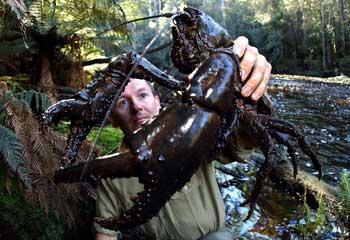Posted by Zara Gladman | Last updated on July 29, 2025
My name is Zara and I’m an “astacologist”, which is a fancy way of saying that I study crayfish, lobster-like freshwater crustaceans of which there are more than 640 described species. In Australia, they go by the name of “yabby” (as in “Yabby Creek” – Home and Away fans will understand). In the American South, they’re called “crawfish” (Elvis Presley sang a rather catchy song about them in the film King Creole). In other parts of the world, they’re known as “crawdads” or “mudbugs”.
Crayfish are a fantastically diverse group, ranging in size from the tiny (2.5 cm) swamp crayfish (Tenuibranchiurus glypticus) of Australia to the giant Tasmanian crayfish (Astacopsis gouldi), which grows to over 80 cm and can weigh a whopping 5 kilograms! Crayfish are also diverse in their choice of habitat, surviving in rivers, lakes and even caves. And they’re not fussy eaters either, feeding on anything from plants and detritus to invertebrates (including each other), amphibians and fish.

The Tasmanian giant crayfish
Unfortunately, many crayfish species, including the swamp crayfish, Tasmanian giant crayfish and our very own British white-clawed crayfish (Austropotamobius pallipes), are endangered. Some of the biggest threats include the spread of non-native crayfish species, disease and habitat loss. I’ll be blogging about the impact of non-native crayfish soon. Until then, you can find out which crayfish species you are by taking this quiz here!
Crayfish have been of interest to humans throughout history, primarily as a food source. Swedes are particularly passionate about eating crayfish and throw crayfish parties, “kräftskiva” every August: a terrific excuse to meet with friends and family, wear silly hats, drink snaps and dine outside on a summer night.

A “crayfish party” in Sweden
About Zara Gladman
Dr. Zara Gladman is a science communicator and comedian with a PhD in Ecology from the University of Glasgow and over 13 years of experience in public engagement. She develops national training programs, leads research festivals, and supports scientists in building creative, community-focused projects. Her alter ego “Lady Alba” went viral during the Scottish Independence Referendum, and her 2024 comedy debut sold out twice. She uses humour, clarity, and originality to make science feel accessible and human.
Category: Nature
Tags: crayfish, nature, wildlife
